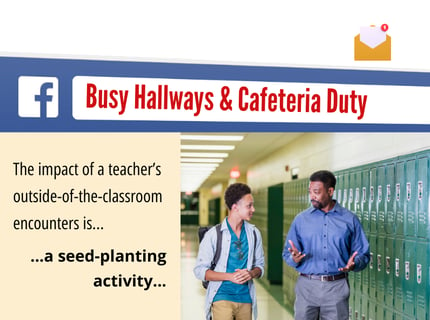
Busy Hallways and Cafeteria Duty
I recently received the kind of letter teachers dream about, the kind of letter that tells you all the blood, sweat, and tears really did matter. (Okay, it wasn’t an actual letter. This is the 21st century after all. It came via Facebook Messenger.)
4/19/20242 min read


A student who’d graduated in ‘99 wrote to tell me how one word of encouragement about his writing had stuck with him over the years and impacted him so greatly that he was working on writing a memoir.
In the letter he recounted a very specific memory of me encouraging him as a writer. The details of the memory aren’t significant, but the hope and encouragement he received from that interaction impacted him with a force that continues to this day.
Ironically, I can’t remember that specific encounter (though I do remember others). But what I do know is that it didn’t happen in my classroom during class time. Reflecting on my years as a classroom teacher, I realize that little of the meaningful connection I had with students happened during class time.
Outside of my classroom–that’s where the social/emotional connections took place–in busy hallways, on cafeteria duty, after school, at an evening event.
In my classroom I was all business, focused on academic excellence, on holding a standard for work and behavior and attitude. No politics, no emotional introspection, no lessening of requirements. Expectations, standards, skills–the equipping they needed for success–that was the stuff of the classroom.
Outside of my classroom I looked for opportunities to talk to students, to laugh with them, to encourage them, to share disappointments.
In my classroom I explained WHY we did the hard work, WHY it mattered, HOW it was equipping them.
Outside of my classroom I developed relationships that showed them I cared, that I was invested.
Education is in trouble these days. Everyone knows it. The expectations of teachers are extreme and overwhelming. Students are struggling in many different ways. Parents don’t know what to do. Much of the “outside-of-the-classroom” work is now expected “in the classroom.”
That muddles things. Confuses priorities. Outside-of-the-classroom priorities are different from in-the-classroom priorities.
The impact of a teacher’s outside-of-the-classroom encounters is NOT measurable in a data-driven, quantifiable way. It’s a seed-planting activity, many of which may lie dormant for 25 years, many of which may never sprout.
A teacher can’t create or force a connection with every student, and they shouldn’t be expected to.
Students who share our affinities will naturally be drawn to us. Those are the ones we should seek to encourage: to see past the misbehavior to the brewing hurt or anger, to discern the loneliness masked as indifference, to identify the spark of raw talent and ability and breathe life and hope into it.
Perhaps one way forward, out of the troubled state of education, is to recognize the difference between the kind of work done in the classroom from the kind of work done outside the classroom.


